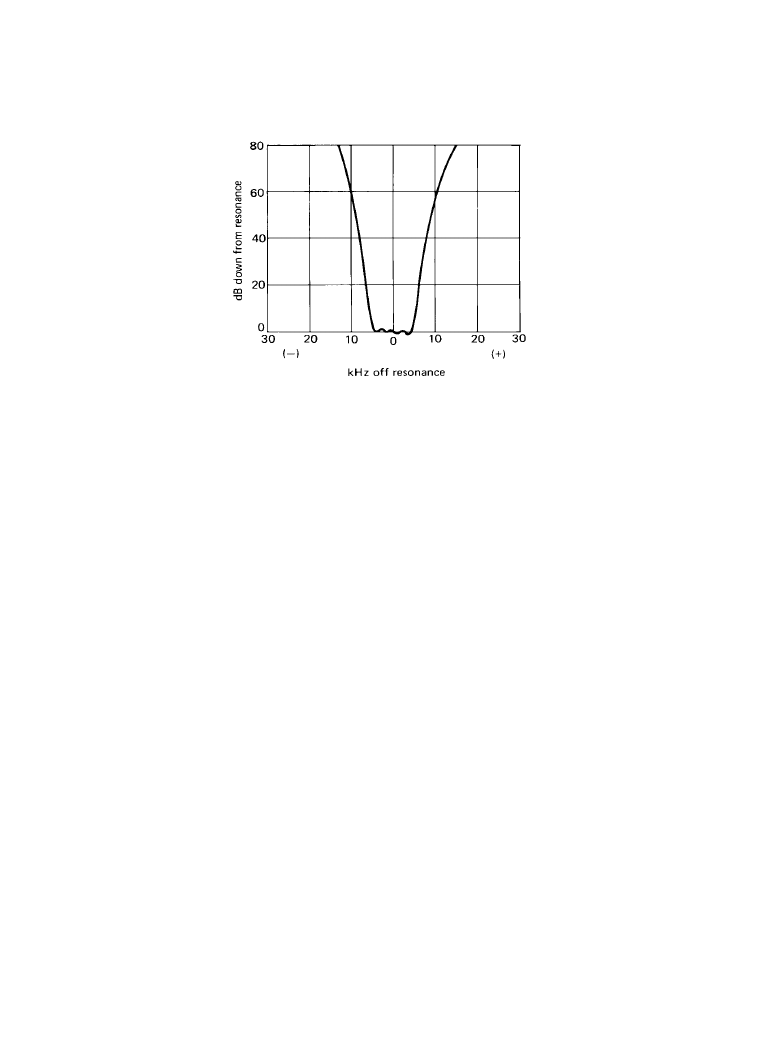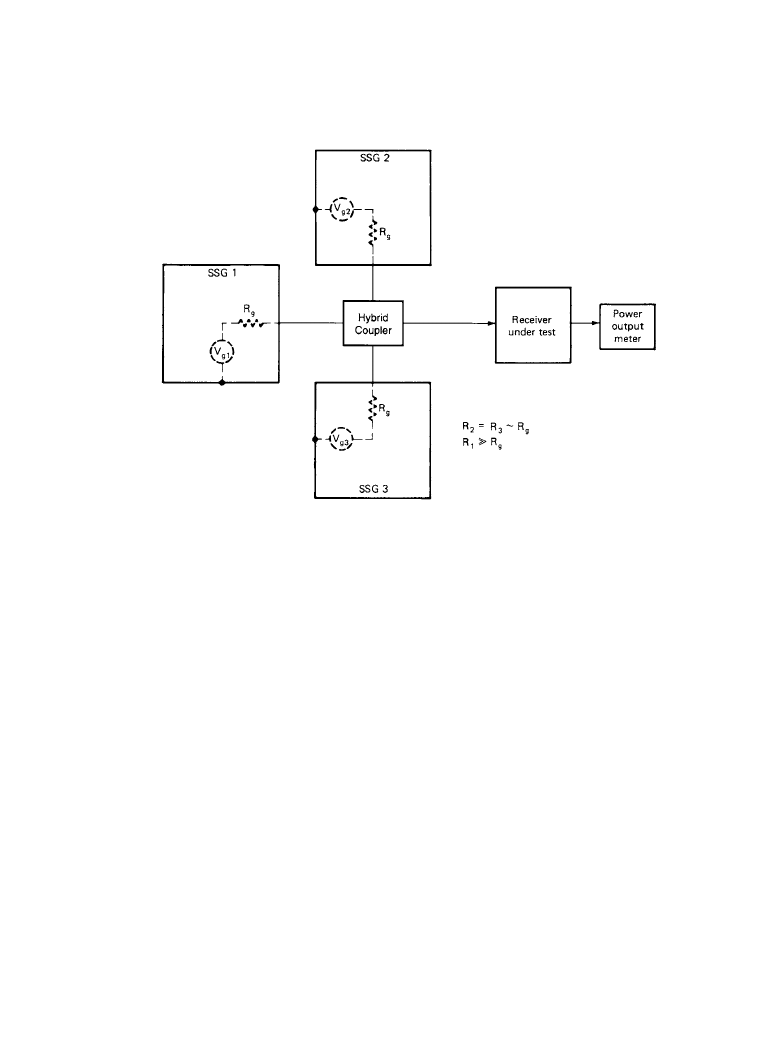ВУЗ: Казахская Национальная Академия Искусств им. Т. Жургенова
Категория: Книга
Дисциплина: Не указана
Добавлен: 03.02.2019
Просмотров: 21624
Скачиваний: 19

Receiver Characteristics 12-13
power, just equal to the noise power, is defined as the MDS. Because receiver noise varies with
bandwidth, so does the MDS, which can be expressed as
(12.1.5)
In dBm,
, where B
n
is the noise bandwidth of the receiver. (0
dbm = decibels referenced to 1mW.)
The available thermal noise power per hertz is –174 dBm at 290ºK (63ºF), an arbitrary refer-
ence temperature near standard room temperatures. When any two of the quantities in the expres-
sion are known, the third may be calculated. As in the case of NF measurements, care is required
in measuring MDS, because a large portion of the power being measured is noise, which pro-
duces MDS’ typical fluctuations.
12.1.3 Selectivity
Selectivity is the property of a receiver that allows it to separate a signal or signals at one fre-
quency from those at all other frequencies. At least two characteristics must be considered simul-
taneously in establishing the required selectivity of a receiver. The selective circuits must be
sufficiently sharp to suppress the interference from adjacent channels and spurious responses.
On the other hand, they must be broad enough to pass the highest sideband frequencies with
acceptable distortion in amplitude and phase. Each class of signals to be received may require
different selectivity to handle the signal sidebands adequately while rejecting interfering trans-
missions having different channel assignment spacings. However, each class of signal requires
about the same selectivity throughout all the frequency bands allocated to that class of service.
Older receivers sometimes required broader selectivity at their higher frequencies to compensate
for greater oscillator drift. This requirement has been greatly reduced by the introduction of syn-
thesizers for control of LOs and economical high-accuracy and high-stability crystal standards
for the reference frequency oscillator. Consequently, except at frequencies above VHF, or in
applications where adequate power is not available for temperature-controlled ovens, only the
accuracy and stability of the selective circuits themselves may require selectivity allowances
today.
Quantitatively the definition of selectivity is the bandwidth for which a test signal x decibels
stronger than the minimum acceptable signal at a nominal frequency is reduced to the level of
that signal. This measurement is relatively simple for a single selective filter or single-frequency
amplifier, and a selectivity curve can be drawn showing the band offset both above and below the
nominal frequency as the selected attenuation level is varied. Ranges of 80 to 100 dB of attenua-
tion can be measured readily, and higher ranges—if required—can be achieved with special care.
A test setup similar to Figure 12.1.2 may be employed with the receiver replaced by the selective
element under test. Proper care must be taken to achieve proper input and output impedance ter-
mination for the particular unit under test. The power output meter need only be sufficiently sen-
sitive, have uniform response over the test bandwidth, and have monotonic response so that the
same output level is achieved at each point on the curve. A typical IF selectivity curve is shown
in Figure 12.1.3.
MDS
k T B F
n
=
MDS
174
–
10
B
n
NF
+
(
)
log
+
=
Downloaded from Digital Engineering Library @ McGraw-Hill (www.digitalengineeringlibrary.com)
Copyright © 2004 The McGraw-Hill Companies. All rights reserved.
Any use is subject to the Terms of Use as given at the website.
Receiver Characteristics

12-14 Broadcast Receiver Systems
The measurement of overall receiver selectivity, using the test setup of Figure 12.1.2, presents
some difficulties. The total selectivity of the receiving system is divided among RF, IF, and base-
band selective elements. There are numerous amplifiers and frequency converters, and at least
one demodulator intervening between input and output. Hence, there is a high probability of non-
linearities in the nonpassive components affecting the resulting selectivity curves. Some of the
effects that occur include overload, modulation distortion, spurious signals, and spurious
responses. If there is an AGC, it must be disabled so that it cannot change the amplifier gain in
response to the changing signal levels in various stages of the receiver. If there is only an AM or
FM demodulator for use in the measurement, distortions occur because of the varying attenua-
tion and phase shift of the circuits across the sidebands.
When measuring complete receiver selectivity, with either a modulated or nonmodulated sig-
nal, it is wise to use an output power meter calibrated in decibels. The measurement proceeds as
described previously. However, if any unusual changes in attenuation or slope are observed, the
generator level may be increased in calibrated steps; it should be noted whether the output
changes decibel for decibel. If not, what is being observed at this point is not the selectivity
curve, but one of the many nonlinearities or responses of the system.
12.1.4 Dynamic Range
The term dynamic range, especially in advertising literature, has been used to mean a variety of
things. We must be especially careful in using a common definition when comparing this charac-
teristic of receivers. In some cases, the term has been used to indicate the ratio in decibels
between the strongest and weakest signals that a receiver could handle with acceptable noise or
distortion. This is the ratio between the signal that is so strong that it causes maximum tolerable
distortion and the one that is so weak that it has the minimum acceptable S/N. This measure is of
limited value in assessing performance in the normal signal environment where the desired sig-
Figure 12.1.3
Example of an IF selectivity curve.
Downloaded from Digital Engineering Library @ McGraw-Hill (www.digitalengineeringlibrary.com)
Copyright © 2004 The McGraw-Hill Companies. All rights reserved.
Any use is subject to the Terms of Use as given at the website.
Receiver Characteristics

Receiver Characteristics 12-15
nal may have a range of values, but is surrounded by a dense group of other signals ranging from
very weak to very strong. The selective circuits of a receiver can provide protection from many
of these signals. However, the stronger ones, because of the nonlinearity of the active devices
necessary to provide amplification and frequency conversion, can degrade performance substan-
tially. In modern parlance, dynamic range refers to the ratio of the level of a strong out-of-band
signal that in some manner degrades signal performance of the receiver to a very weak signal.
The most common weak signal considered is the MDS, and differing strong degrading signal
levels may be used. It is, therefore, important to know which definition is meant when evaluating
the meaning of the term dynamic range.
If the foregoing discussion of dynamic range seems vague, it is because there is not one char-
acteristic but several that is encompassed by the term. Each may have a different numeric value.
A receiver is a complex device with many active stages separated by different degrees of selec-
tivity. The response of a receiver to multiple signals of different levels is extremely complex, and
the results do not always agree with simple theory. However, such theory provides useful com-
parative measures. If we think of an amplifier or mixer as a device whose output voltage is a
function of the input voltage, we may expand the output voltage in a power series of the input
voltage
(12.1.6)
where a
1
is the voltage amplification of the device and the higher-order a
n
cause distortion.
Because the desired signal and the undesired interference are generally narrow-band signals,
we may represent V
i
as a sum of sinusoids of different amplitudes and frequencies. Generally
, as a result of trigonometric identities, produces a number of com-
ponents with different frequencies,
, with m taking on all values from 0 to n.
These intermodulation (IM) products may have the same frequency as the desired signal for
appropriate choices of f
1
and f
2
. When n is even, the minimum difference between the two fre-
quencies for this to happen is the desired frequency itself. This type of even IM interference can
be reduced substantially by using selective filters.
When n is odd, however, the minimum difference can be very small. Because m and n – m can
differ by unity, and each can be close to the signal frequency, if the adjacent interferer is
from
the desired signal, the second need be only
/ further away for the product to fall
at the desired frequency. Thus, odd-order IM products can be caused by strong signals only a few
channels removed from the desired signal. Selective filtering capable of reducing such signals
substantially is not available in most superheterodyne receivers prior to the final IF. Conse-
quently, odd-order IM products generally limit the dynamic range significantly.
Other effects of odd-order distortion are desensitization and cross modulation. For the case
where n is odd, the presence of the desired signal and a strong interfering signal results in a prod-
uct of the desired signal with an even order of the interfering signal. One of the resulting compo-
nents of an even power of a sinusoid is a constant, so the desired signal is multiplied by that
constant and an even power of the interferer’s signal strength. If the interferer is sufficiently
strong, the resulting product will subtract from the desired signal product from the first power
term, reducing the effective gain of the device. This is referred to as desensitization. If the inter-
ferer is amplitude-modulated, the desired signal component will also be amplitude-modulated by
V
a V
o
n
i
n
= Σ
A
1
2
sin
πf
1
t
A
2
2
πf
2
t
)
n
sin
+
(
mf
1
n
m
–
(
)f
2
±
ξ f
2
ξ f
(
)
n
1
–
(
)
⁄
Downloaded from Digital Engineering Library @ McGraw-Hill (www.digitalengineeringlibrary.com)
Copyright © 2004 The McGraw-Hill Companies. All rights reserved.
Any use is subject to the Terms of Use as given at the website.
Receiver Characteristics

12-16 Broadcast Receiver Systems
the distorted modulation of the interferer. This is known as cross modulation of the desired signal
by the interfering signal.
This discussion provides a simple theory that can be applied in considering strong signal
effects. However, the receiver is far more complicated than the single device, and strong signal
performance of single devices by these techniques can become rapidly intractable as higher-
order terms must be considered. Another mechanism also limits the dynamic range. LO noise
sidebands at low levels can extend substantially from the oscillator frequency. A sufficiently
strong off-tune signal can beat with these noise sidebands in a mixer, producing additional noise
in the desired signal band. Other characteristics that affect the dynamic range are spurious sig-
nals and responses, and blocking.
The effects described here occur in receivers, and tests to measure them are essential to deter-
mining the dynamic range. Most of these measurements involving the dynamic range require
more than one signal input. They are conducted using two or three signal generators in a test
setup such as that indicated in Figure 12.1.4.
12.1.4a
Desensitization
Desensitization measurements are related to the 1-dB compression point and general linearity of
the receiver. Two signal generators are used in the setup of Figure 12.1.4. The controls of the
receiver under test are set as specified, usually to one of the narrower bandwidths and with MGC
set as in sensitivity measurements so as to avoid effects of the AGC system. The signal in the
operating channel is modulated and set to a specified level, usually to produce an output S/N or
SINAD measurement of a particular level, for example, 13 dB. The interfering signal is moved
off the operating frequency by a predetermined amount so that it does not affect the S/N mea-
surement because of beat notes and is then increased in level until the S/N measurement is
reduced by a specified amount, such as 3 dB. More complete information can be obtained by
varying the frequency offset and plotting a desensitization selectivity curve. In some cases, limits
for this curve are specified. The curve may be carried to a level of input where spurious
responses, reciprocal mixing, or other effects prevent an unambiguous measurement. Measure-
ments to 120 dB above sensitivity level can often be achieved.
If the degradation level at which desensitization is measured is set to 1-dB, and the desensitiz-
ing signal is well within the passband of the preselector filters, the desensitization level corre-
sponds to the 1 dB gain compression (GC), which is experienced by the system up to the first
mixer. (See the subsequent discussion of intermodulation and intercept points.) A gain compres-
sion (or blocking) dynamic range can be defined by comparing the input signal level at 1-dB GC
to the MDS, i. e., dynamic range (dB) equals the GC (input dBm) minus the MDS (input dBm).
This is sometimes referred to as the single-tone dynamic range, because only a single interfering
signal is needed to produce GC.
12.1.4b AM Cross Modulation
Although many saturation effects in receivers have been called cross modulation, SSB and FM
are not cross-modulated in the same sense as described previously. Cross modulation occurs in
AM and VSB signals by a strong modulated signal amplitude-modulating a weak signal through
the inherent nonlinearities of the receiver. Cross modulation typically occurs in a band allocated
for AM use and requires a much higher interfering signal level than for the generation of IM
Downloaded from Digital Engineering Library @ McGraw-Hill (www.digitalengineeringlibrary.com)
Copyright © 2004 The McGraw-Hill Companies. All rights reserved.
Any use is subject to the Terms of Use as given at the website.
Receiver Characteristics

Receiver Characteristics 12-17
products. The typical measurement setup is similar to that for overload measurements, except
that the interfering signal is amplitude-modulated, usually at a high level, such as 90 percent. The
modulation is at a different frequency than that for the operating channel (if it is modulated), and
a band-pass filter is used in the output to assure that the transferred modulation is being mea-
sured. The out-of-channel interfering signal is increased in level until the desired signal has a
specified level of output at the cross modulation frequency, for example, the equivalent of 10
percent modulation of the desired carrier. One or more specific offsets may be specified for the
measurement, or a cross-modulation selectivity curve may be taken by measuring carrier level
versus frequency offset to cause the specified degree of cross modulation.
In analog television systems, cross modulation can result in a ghost of an out-of-channel mod-
ulation being visible on the operating channel. The so-called three-tone test for television signals
is a form of cross-modulation test.
12.1.4c
IM
As described in previous sections, IM produces sum and difference frequency products of many
orders that manifest themselves as interference. The measurement of the IM distortion perfor-
mance is one of the most important tests for a communications receiver. No matter how sensitive
a receiver may be, if it has poor immunity to strong signals, it will be of little use. Tests for even-
order products determine the effectiveness of filtering prior to the channel filter, while odd-order
Figure 12.1.4
Test setup for measuring the dynamic range properties of a receiver.
Downloaded from Digital Engineering Library @ McGraw-Hill (www.digitalengineeringlibrary.com)
Copyright © 2004 The McGraw-Hill Companies. All rights reserved.
Any use is subject to the Terms of Use as given at the website.
Receiver Characteristics